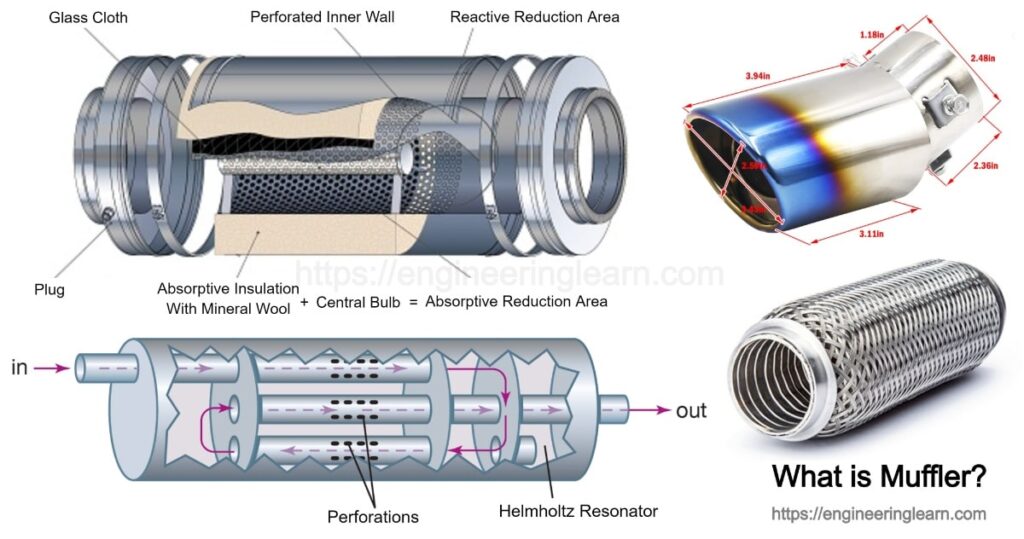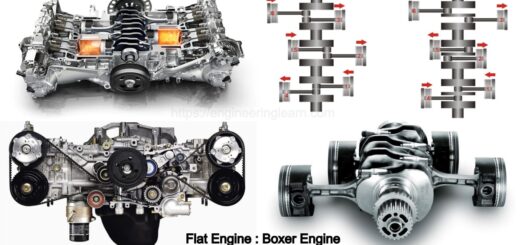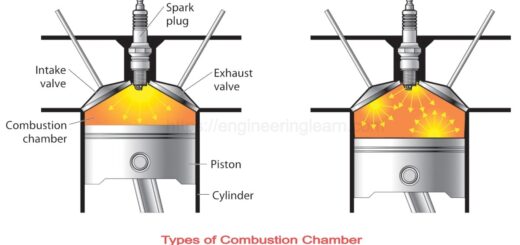Types of Muffler: Silencer & Muffler Exhaust

What is Muffler?
Types of Muffler :- A muffler is also known as silencer in laymen term. Its main function is to reduce the exhaust noise of an internal combustion engine. The exhaust gas coming out of the engine is at very high pressure (~10-30 ATM). If the gas come out directly in to the atmosphere, a very unpleasant sound is generated due to sudden expansion of the high pressure exhaust gas. This may also generate a high pressure shock wave which can damage the exhaust manifold of the engine.
Thus, to precure this damage and run the vehicle quietly, the engine requires a device which can reduce the exhaust pressure and also absorb the noise during the expansion. The device used to perform this operation is known as muffler. The muffler is generally placed at the end of the exhaust manifold.
The capacity of muffler should be large enough to handle the exhaust gases of the engine. Also, it should sufficiently reduce the pressure of exhaust gas near to the atmospheric pressure, so that there will as much less noise as possible. The muffler design should be very smooth so that there would be no obstruction for the exhaust gas to flow inside it. Any obstruction may cause backflow of the exhaust gas, leads to reduction in engine efficiency and engine life.
Types of Mufflers ( Types of Silencer )
There are mainly five types of mufflers are generally used to serve the purpose;
1. Baffle Type Muffler: ( Types of Muffler )
The flow pipe of this type of muffle having number of baffles which restricts the exhaust gases to directly pass through the system. Instead, there are many secondary passages are made in the flow pipe so that exhaust gas will pass through this secondary passage and thus, the gas has to travel a longer path in the system. The long travel path definitely reduces the pressure and temperature of the gas but due to restriction in flow, because of baffles, the back pressure is generated in the system which may further lead to degrade the engine efficiency and performance.
2. Wave Cancellation Type Muffler: ( Types of Muffler )
In this type of muffler, as the exhaust gas enters into it, the gas is divided into two equal streams. Both streams of gas move along the long path and then return back to a single point where the streams get merged and start moving towards the outlet as a single stream. The length of the passage that contains the separated stream are designed in such a way that at the merging point the crest of one wave (stream) merged with the trough of another wave (stream).
Thus, both waves cancel the amplitude of each other and theoretically reduces the noise to the zero level. But, practically the zero noise is impossible in the system because the noise produced by an engine is at different frequency while running at different speeds. However, the wave cancellation type muffler reduces the noise significantly up to the acceptable level.
3. Resonance Type Muffler: ( Types of Muffler )
This type of muffler consists of a series of Helmholtz resonator. The flow pipe passes through this resonator. The flow pipes are having access ports through which the gas flows into the resonator. The resonator generates the destructive frequencies which when superimposed over the noise wave of the exhaust gas, the resonance occurs. Thus, the frequency of noise wave gets diminished up to very low extent, and hence significant elimination of the noise takes place. This kind of resonator is very helpful at engines which is not having ample space to fit other type of muffler.
4. Absorber Type Muffler: ( Types of Muffler )
This is the most common type of muffler used in now days. This muffler consists of a perforated tube (a tube having ‘n’ number of small fine holes) and around this tube the sound or noise absorbing material such as steel wool, fiber glass etc. are wrapped. As the exhaust gas passes through this perforated tube, the noise absorbing material provides the cushioning effect to the high pressure fluctuation of the exhaust gas. Due to this phenomenon, the pressure intensity of the exhaust gas decreases and thus level of exhaust noise gets reduced up to acceptable range. Generally, the flow pipes are straight through, but, sometimes the helical coiled pipes are also used to increase the passage length.
5. Combined Type Muffler: ( Types of Muffler )
This kind of muffler consist the combination of absorber type muffler and resonance type muffle. The design of combined type muffler made in such a way that the exhaust gas first pass through the absorber type area, which contains the similar setup as described in preceding segment (4th type of muffler). At the end of the flow tube, instead of perforation, an access port is created and over this port the Helmholtz resonator is fixed.
In some cases, the absorber type and resonance type zone are completely separated and connected through the flow pipe. The exhaust gas first flow through the absorber type and then passes through the resonance type zone. The combined effect of absorber and resonator leads to reduce the noise at very minimum level.
Generally, the mufflers are provided with the vehicle itself. Those mufflers are basically designed on certain norms such as Euro norms or Bharat Stage (BS) norms. These norms contain some set of rules that is necessary to avoid air and noise pollution. After few years the norms get revised and more strict than the previous one just for the sake of sustainable development and less pollution. In India, currently, the BS-VI norms are applicable. The violation of these norms are a punishable offence and government is very strict towards it. Any vehicle to perform well requires three important things; A good focused light, A suitable muffler, and A efficient brakes!!!
Image Source :- boilerwork, britannica,













